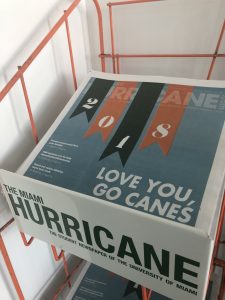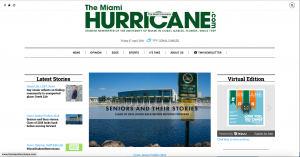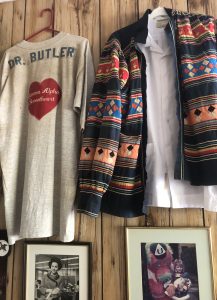Posted May 1, 2018
By PATRICIA SANTANA
The bright orange newsstands are found all over campus: from just outside the elevator bank on the second floor of the Shalala Student Center to outside the Bowman Foster Ashe classroom building to as far as the fifth floor of the Flipse Building on the remote end of campus.

This orange newsstand stands outside the elevator bank on the second floor of the Shalala Student Center. It’s stocked with the spring semester’s final issue of the Hurricane (Photo by Patricia Santana).
They’re a fixture of campus scenery, as common as the infamous Muscovy ducks and the wide-eyed tour groups being led around by an orange polo. Each one is kept carefully stocked, the tall pile of newspapers beckoning passersby to get informed with the latest issue of The Miami Hurricane.
The Miami Hurricane, colloquially known as simply the Hurricane, is quickly approaching its 90th anniversary year. In those 90 years, the Hurricane has always been evolving, dealing with new challenges, and inspiring its staff and readers.
Lynn Carrillo, current vice president of NBC Universal News Group Legal and editor-in-chief of the paper for the 1995-96 academic year, oversaw the creation of its digital platform.
“I think that was a turning point for the Hurricane,” Carrillo said.
Carrillo added that the effort to put the Hurricane online “took a lot of collaboration with the university.” She met regularly with a number of university of officials, including Dr. William R. Butler and Dr. Patricia A. Whitely, the then vice president of Student Affairs and the director of Student Life, respectively.
Another figure that Carrillo described as essential to the digitization of the Hurricane was Raymonde Bilger, an assistant to Butler who worked with the Hurricane on their financial side.
“She was an incredible asset to the Hurricane,” Carrillo said. “She believed in us.”
Butler described Bilger as “knowledgeable about computerization before the university ever thought about it.”
This shift was not the only one that occurred during Carrillo’s tenure.
Carrillo said that prior to her, special editions were not a frequent occurrence for the Hurricane, but she oversaw the creation of many.
“We put out special editions for the opening of the Wellness Center, special editions for the 90th anniversary of the university,” Carrillo said. She added that the Hurricane was the official publication for distributing the plans for the Wellness Center.
According to Carrillo, Butler was “a great proponent of The Miami Hurricane” and many of the special editions came about thanks to him. When he announced his retirement, there was a special edition for him, too.
Editors-in-chief following Carrillo also had to grapple with the increasing influence of the online world and making sure the Hurricane kept up.
“Once I was editor-in-chief, we had to grapple with what Facebook meant to everybody,” said Patricia Mazzei, current Miami bureau chief for The New York Times and editor of the Hurricane for all of 2005 and the 2006 fall semester. Mazzei is also the only person to have ever served as editor-in-chief of the paper as a sophomore.
Under Mazzei, the paper published a story on an incident where some students jumped into the lake after the football team defeated Virginia Tech and uploaded a photo album to Facebook where they described themselves as “drunk idiots.” Mazzei said that the story made the student body aware of the “concerns over putting your life out in public back when Facebook was so new” and that prior to it, people did not fully comprehend that they were putting out incriminating information in an easily accessible manner.
Since Facebook at that time was still limited to college students, the Hurricane was not active on it, though it was a useful sourcing tool for reporters according to Mazzei.
The website had not yet become a source for breaking news the way it is today. Mazzei said every issue was uploaded but only after the print version came out. There was a webmaster maintaining the site, but no online editor managing content creation specifically for the site.
“The website wasn’t what it is now, where stuff would get put online right away and print is secondary,” Mazzei said. “We were really focused on our twice-a-week deadline at the time.”
The position of online editor was created under Bob Radziewicz, faculty advisor for the Hurricane from 2007 to 2014. Radziewicz said the change happened to better enable instant coverage of breaking stories.
“We didn’t wait for the paper,” Radziewicz said. “We would get out in front of it as soon as we could.”
The website was redesigned during his time as advisor and its importance was emphasized more, Radziewicz said. There was also an increase in the creation of video and audio content for the website. The focus on digital was a response to the “reality of how the journalism industry has moved,” Radziewicz said.
The transition to more of an online presence was not always smooth. In 2016, it led to a decision to cut the published newspaper from twice-a-week to once-a-week. The paper had been published twice a week since Butler proposed the change soon after he became vice president of Student Affairs.
“Sometimes it was hard to get the administration to see eye to eye with us on the importance of digital,” said Julie Harans, the 2016-17 editor-in-chief of the paper. Harans said there was an attachment to the tradition of the print paper and a desire to maintain that.
According to Harans, the staff “pushed more of the online” content and “a lot more video, a lot more multimedia” during her time as part of this increased focus on the paper’s digital platform.
Isabella Cueto, the outgoing editor-in-chief for the current academic year, emphasized the hard work that goes into maintaining a thriving online presence.
“It’s difficult because adapting to digital means more work and more hours of work and more people with diverse skill sets,” Cueto said. “It’s not just laying things out on a page.”
Cueto said there are new tasks to worry about, such as website maintenance and poring over the analytics for the online content.

The homepage of The Miami Hurricane’s website. The homepage provides links to the paper’s social media pages and to the print edition’s cover stories.
But the hard work has not been without reward.
“It definitely has helped with our visibility and readership,” Cueto said.
The online presence has also changed the nature of the business side of the Hurricane, as they can now sell digital advertisements. But according to Cueto, this also comes with the problem of the print advertisements becoming less desirable. A remedy to this that the staff is currently using is selling a package that combines print and digital advertisements.
Last semester, Cueto introduced a new digital element to the paper: an e-mail newsletter.
Cueto said she uses newsletters to stay informed when she’s busy and thought students could use something similar.
“It’s gotten a really good response,” Cueto said. “Our analytics are very good.”
Professor Tsitsi Wakhisi, current faculty advisor for the Hurricane, said digital coverage has increased during her tenure.
“We’re using social media to promote the stories,” Wakhisi said.
Wakhisi said she stays on top of the website and social media pages every day.
“We’re still facing the goal of how to be more digital, more online, how to get the students to see us,” Wakhisi added.
The staff is always brainstorming new ways to engage readers.
“They voted down getting an app,” Wakhisi said. The staff decided instead that they wanted to put more resources into the newsletter, as they didn’t think students would use an app.
The Hurricane has not gone without times of tension and controversy in its illustrious history.
“There have been ups and downs of the Hurricane,” said Dr. Patricia A. Whitely, current vice president of Student Affairs.
Around the early 1980s, the Miami Herald tried to rescind its printing services for the newspaper.
“The Herald did not see the Hurricane as an economic benefit,” Bilger said.
Bilger convinced the Herald to keep the Hurricane because she felt very strongly about maintaining that relationship for the sake of the students. Bilger described the employees of the Herald as being very kind to the students, helping them lay out the paper and willing to teach them things about the professional world of journalism. She said she did not want the students to lose that experience.
“It was very difficult to find a printer in Miami that could print,” Bilger added.
In 1993, the Hurricane published a full-page Holocaust denial advertisement paid for by David Horowitz. Horowitz was at the time trying to put his advertisement in as many campus newspapers as possible.
Butler said that President Edward T. Foote once described the uproar over this ad as “the most difficult moment in his 20 years as president.”
The student staff of the Hurricane decided to print the advertisement, despite the growing controversy. Whitely said many members of the Board of Trustees at the time threatened to pull their support over the ad, but President Foote allowed its publication.
“The university was committed to free speech on the campus,” Butler said, “and to not censor the paper before its publication.”
Much of the controversy came from off-campus, as according to Butler, “it was okay with the campus pastors.”
Whitely said a controversial ad policy was created as a direct response to this incident.
The staff donated the revenue from the advertisement to the Holocaust Museum in Washington, D.C.
After 33 years with the Herald, the Hurricane switched to Suncoast Print Solutions this semester to print the physical edition of the newspaper.
“We thought it was time to make a change,” said Ryan Yde, the current business manager of the Hurricane.
The move came about partially because of growing dissatisfaction with the Herald’s pre-production mistakes and lack of attention to detail, according to Yde.
“They printed the same page twice and didn’t realize,” Yde said.
The change has led to savings of several hundred dollars a week and cheaper delivery fees. Suncoast also allowed the Hurricane to switch to thicker, sturdier paper with more vibrant colors at a cheaper price point than the Herald was offering.
There have been various stories over the years that created tension between the paper and some administrators or have invited responses from the administration.
When Carrillo was editor-in-chief, the paper covered a scandal at the law school and, as a result, she had to meet with the dean of students in the law school.
“But she respected what I did,” Carrillo said.
Prior to Mazzei’s tenure, the group of editors had a “big focus on the arts and music scene” and were interested in “competing more with the Miami New Times.”
“Some of that was edgy and the administration didn’t like it,” Mazzei said.
“Our friction with the administration was over the strike the janitors had,” Mazzei added. The strike was over better wages and affordable health insurance.
Mazzei also mentioned an incident where the paper published negative coverage of a fraternity and copies of the paper mysteriously disappeared. The culprits were never caught nor is it known if they were associated with the fraternity from the article.
“That tended to happen when a big group didn’t like it,” Mazzei said. “They would go out and get the paper and trash it, so people couldn’t read it.”
Whitely also described an incident where a little after the 9/11 terrorist attacks, the newspapers were stolen, and controversial things were being said about Muslim students.
“We did a story on the financial aid office last year,” Cueto said. “We put a lot of work into that one because we knew that if we were going to take on the financial aid office and by default, the university, we had to have all the facts right.”
The story involved gathering stories from students on their financial aid experience and asking the office why students were having those experiences. The office claimed the problems weren’t happening and denied the existence of the term “accidental aid,” something students often hear from financial aid advisors when asking why some of their aid was taken away.
Cueto said the publication of the story led to an angry email from the director of the Office of Student Financial Assistance, Dr. Raymond Nault-Hix, claiming that many of the facts were wrong. When asked to clarify which ones, he never answered.
Despite these conflicts, administrators follow a policy of being hands-off with the newspaper and it continues to be a free press.
“We agreed that the university would not oversee the Hurricane until after it was published,” Butler said.

Hanging on the wall of Dr. William R. Butler’s home are an Iron Arrow jacket and a sweater proclaiming him Gamma Alpha’s sweetheart. Butler is fondly remembered by students, his support of student media being one of many reasons (Photo by Patricia Santana).
Whitely described her role as hands-off but supportive.
“I’ve always tried to be very accessible to the editors,” Whitely said.
Despite all the changes and conflicts, some things at the Hurricane have always stayed the same.
Their prestigious status as a reliable award-winner is one of them. The Hurricane is an Associated College Press “Hall of Fame” newspaper and wins a number of awards from them, and other organizations, year after year.
“I was always proud of the paper because they were always winning prizes,” Butler said.
The value of student media and being a student journalist hasn’t changed either, and responses from people who worked on or with the paper decades apart share common themes.
“I think it helped make me the executive I am today,” Carrillo said. “I learned an incredible amount from those leaders.”
Carrillo cited people such as Butler, Bilger and then-advisor Sig Splichal as people she was blessed to have the opportunity with which to work.
“I think [student media] is critical for any student who wants to be in media upon graduation,” Wakhisi said.
Harans echoed Wakhisi’s sentiment, saying that “just being able to work in a professional newsroom” is invaluable and it prepared her for the higher stakes on working in the real world.
Another thing people hope continues into the future? The “family vibe,” Harans said.
“I think student newspapers and student newsrooms are always going to be this wonderful place,” Cueto said. “Like a second home.”
